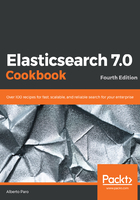
How it works…
The node.master parameter establishes that the node can become a master for the cloud. The default value for this parameter is true. A master node is an arbiter for the cloud; it takes decisions about shard management, keeps the cluster status, and is the main controller of every index action. If your master nodes are on overload, all the clusters will have performance penalties. The master node is the node that distributes the search across all data nodes and aggregates/rescores the result to return them to the user. In big data terms, it's a Redux layer in the Map/Redux search in Elasticsearch.
The number of master nodes must always be even.
The node.data parameter allows you to store data in the node. The default value for this parameter is true. This node will be a worker that is responsible for indexing and searching data.
By mixing these two parameters, it's possible to have different node types, as shown in the following table:

The most frequently used node type is the first one, but if you have a very big cluster or special needs, you can change the scopes of your nodes to better serve searches and aggregations.